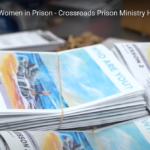A Rock in a Weary Land
The churches call to action an Era of Mass-Reintegration
By. Rev. Dr. Lori E. Banfield
Exodus 13:17-18 NLT
God said, “If the people are faced with a battle, they might change their minds and return to Egypt.” So God led them in a roundabout way through the wilderness toward the Red Sea. Thus the Israelites left Egypt like an army ready for battle.
In the world of psychology, we clinicians often say awareness is the first step to deliverance or recovery. But I must clarify, it is a step, not a bridge! Though awareness is the first essential step, said step alone does not guarantee healing or restoration; only conviction, presence, and gracious discipline can foster a spiritually resilient restoration. A resilient quest for restoration is essential as former inmates seek to navigate the roundabout wilderness-like trek of reintegration.[1]
The last decade has seen a growing awareness and spotlighting of mass incarceration – the punitive judicial and corrections system drenched in the blood of racial caste. Numerous researchers, advocates, authors, and artists have done brilliant due diligence to vividly portray the multilayered crisis of policing and mass incarceration in America.[2] The antecedents and impact of the era of mass incarceration has become a global exposition. Great attention and awareness of injustice within the corrections system has resulted in a concerted effort by some organization and churches to face the disenfranchised reality plaguing urban communities and advocate for restorative justice.
But, while I have been glad to see people –especially congregations awakening to the evils of the era of mass incarceration, I can’t help but be shaken by the urgency of the subsequent era we, as a nation, have inconspicuously entered: the era of mass reintegration. In 2007 the correctional population (jails, prisons, parole and probation) peaked at 7.3 million adult citizens.[3] Fast forward ten years later the correctional population in 2018 stood at 6.5 million adults; a significant drop and sign of hope in context. However, the reality is that those 1 million people released over those ten years met multiple obstacles to a redeemed civil life –lack of access to housing, employment, health care, legal aid, etc. coupled with impaired social capitol due to the stigma of incarceration debilitated any sense of agency for reentry success. Today 95% of current inmates have an intended release date, many of which are approaching.[4] In my home state of Pennsylvania, approximately 35,000 people are released in the city of Philadelphia annually, with 1/3 being rearrested within 1 year of their respective release.
The mass exodus of our brothers and sisters is comparable to the Israelites of old –they may have the stature of an army but are prone to recidivate.[5] The events and encounters within the first 90 days of reentry are critical to the hope of sustained reentry success.[6] Returning citizens long for a sense of community, restored sacred identity, and an incarnational guide through the wilderness of reentry. The church was designed and commissioned to be this very incarnational presence of grace to aid our brothers and sisters through the malaise of not only spiritual depravity but also practical disenfranchisement.
Throughout the biblical narrative God displays great concern for those marginalized and systemically oppressed. The early church finds much of their ministry convening within prison walls, courts of appeals, or meeting the needs of the incarcerated community.[7] In fact, said service is so intracule to the Christian identity that Lucian of Samosata, a late second century pagan writer and caricature artist would mockingly depict Christian’s concepts and services toward the incarcerated.[8] T. Nicklas’ (2016) asserts, “prisoners were regarded [by Christians during the Roman Empire] as victims of a more or less unjust [corrupt and inhumane] system.”[9] The system’s dehumanizing approach has not changed, the Church has. The church has dropped the ball; and in doing so the system’s measures have become more punitive to assert more control for change. We the church must now be accountable to the harvest we have left unattended.
I am inspired by Joseph Williams’ lead development of the Christian Association for Prison Aftercare (CAPA) and the New Creature TOP (Transition of Prisoners) program which places the onus back on the church as the prime institution to combat and replace “anti-social support systems” of the criminal justice system in the life of returning citizens.[10] The state’s limits are the church’s gift! Reentry advocacy initiatives like the Spiritual Resilience Council in Philadelphia, PA has recognized this gift and taken full advantage of the opportunity to aid families affected by incarceration and equip congregations to create sacred spaces of redemption.[11] Redemption Housing (501c3 non profit and CCDA network member) has engrained within our mission to partner with local congregations and Christian institutions in the provision of housing and spiritual mentoring for returning citizens.[12] It is our firm belief that authentic longstanding restoration comes only through sacred transformative community and secure, stable housing. Our Connecting Congregations function as maternal-elephant buffers: supportively surrounding, modeling, and encouraging the vulnerable members of the herd as they activate personal agency.
Now is the time for the all churches to be the bridge of hope firmly grounded in conviction, presence, and gracious discipline. Let us put theory into practice and daily walk with those in their redemptive transition from isolation and survival to thriving in community. In the words of our Lord, “The harvest is great, but the workers are few.”[13] This mission field needs you; it needs your expertise, it needs your compassion. For those who may doubt their ability or capacity to support this journey, I admonish you to consider God’s response to Moses in Exodus 4:2, “What do you have in your hand?” Use, and God will enhance your current gifts, skills, and resources for this ripe vineyard.
- [1] Reintegration: the process of returning to civil society; reentry.
- [2] Alexander, M (2012); Gillard, D. (2018); Stevenson, B. (2014); Netflix Films: “13th” and “When they See Us”
- [3] Bureau of Justice Statistics (2018)
- [4] Banfield, L. (2019)
- [5] Recidivism (recidivate): being rearrested, reconvicted or re-incarcerated for the same or a new criminal offense.
- [6] Lee, M (2016); Romeo, J (2007)
- [7] Banfield, L (2019); Casson, M (2015)
- [8] Nicklas, T. (2016)
- [9] Nicklas, T. (2016), p. 49
- [10] Mills (2010)
- [11] To learn more about the strategy of the Spiritual Resilience Council see Banfield, L (2019)
- [12] www.RedemptionHousing.org
- [13] Luke 10:2




